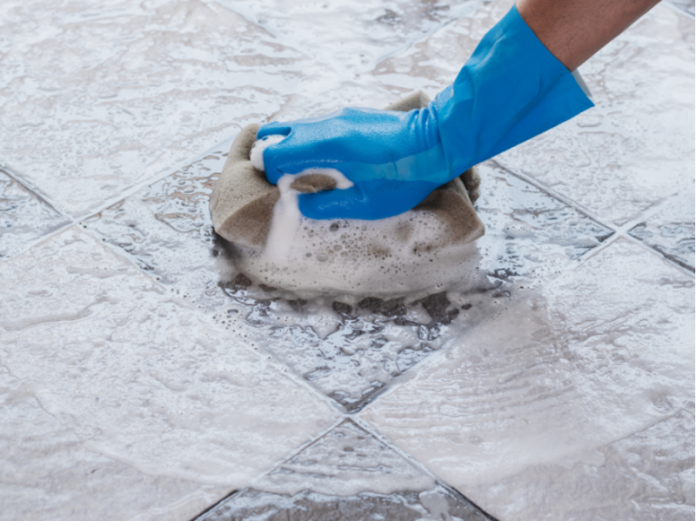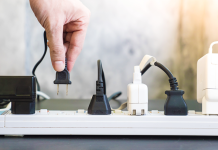Clean outdoor tiles are crucial for boosting your outdoor area’s appearance and guaranteeing the safety of your family and guests. Stains on tiles can turn into slippery hazards, potentially leading to accidents. Furthermore, effectively maintaining tiles elongates their lifespan, ultimately saving you money that would otherwise be spent on replacements.
This article aims to offer a comprehensive manual for naturally eliminating stains from outdoor tiles. By grasping various stain types, assembling the appropriate tile cleaning tools and materials, and adhering to our step-by-step instructions, you can rejuvenate your outdoor tiles’ original charm without resorting to harsh chemicals.
Understanding the Types of Stains
1. Common Outdoor tile stain types
Different outdoor tile stain types can mar the beauty of your outdoor tiles. Understanding these stains and their sources is essential for effective removal and prevention. Here’s a breakdown of various stain types:
- Oil and Grease Stains: These unsightly marks often result from cooking spills or equipment leaks. Outdoor cooking or dining areas are especially prone to these stains, making regular cleaning crucial for a pristine appearance.
- Mould and Mildew Stains: Humid conditions can foster mould growth and mildew on tiles. Not only do these stains affect aesthetics, but they can also pose health risks. Ensuring proper ventilation and cleaning can prevent their occurrence.
- Rust and Metal Stains: Metallic objects or furniture left on tiles can leave rust marks. These stains not only look unappealing but can also be challenging to remove. Avoiding direct contact between metal and tiles can help prevent these marks.
- Organic Stains: Fallen leaves, berries, or other organic matter can leave stubborn stains. These stains are visually displeasing and can become more embedded over time if not promptly addressed.
- Hard Water and Mineral Stains: Mineral deposits from water can leave unsightly marks on tile surfaces. These stains are particularly common in areas with hard water. Regular rinsing and proper maintenance can help minimise their impact.
Understanding these stain types empowers you to take targeted action against them. By addressing the sources of stains and applying appropriate removal techniques, you can maintain the beauty and longevity of your outdoor tiles.
2. Factors influencing stain removal
Effective stain removal hinges on several factors that shape the approach you should take. Here’s an overview:
- Tile Material and Porosity: Diverse tile materials respond in distinct ways to stains, necessitating tailored removal tactics. Some tiles are more porous, absorbing stains more readily. In contrast, others are less porous, influencing the choice of cleaning agents and techniques.
- Age and Severity of the Stain: Older stains tend to embed themselves deeper, demanding greater diligence during removal. The duration of the stain’s presence impacts the level of effort required to completely eliminate it.
- Environmental Factors: The external environment plays a role in stain formation and removal. Variables like climate, humidity levels, and sun exposure can influence the prevalence of stains. Certain conditions can expedite or hinder the stain removal process.
Preparing for Stain Removal
1. Gathering necessary tools and materials
To ensure a smooth stain removal process, assembling the essential tile cleaning tools and materials is vital. Here’s a breakdown:
- Hose and/or Bucket: These are essential for rinsing and applying water, providing the necessary moisture for cleaning.
- Firm-Bristled Broom: Ideal for sweeping away loose dirt and debris before tackling stains, creating a clean surface to work on.
- High-Pressure Washer: While optional, it becomes valuable for more stubborn stains that require additional power for removal.
- Leaf Blower or Blower Vacuum: This optional tool aids in debris removal, minimising the potential for debris interference during cleaning.
- Natural Tile Cleaner: The recommended brand, LITHOFIN VITRA CLEAN, is a reliable choice for effective, environmentally-friendly stain removal.
- Water: Essential for dilution of cleaning solutions and thorough rinsing, ensuring no residue is left behind after cleaning.
2. Ensuring safety precautions
Prioritising safety is essential during the stain removal process. Here’s how to ensure a secure environment:
- Wearing Protective Gear: Safeguard yourself by using protective gloves and eyewear, guarding against direct contact with cleaning agents.
- Well-Ventilated Area: Choose a workspace with proper ventilation to reduce the inhalation of fumes, maintaining a healthier environment.
- Following Instructions: Adhere to the manufacturer’s guidelines for cleaning products, ensuring their correct and safe application. This leads to effective stain removal without risks.
Step-by-Step Guide to Removing Stains from Outdoor Tiles
Step 1: Identifying the stain type
- Visual inspection and analysis: Examine the stain’s appearance, texture, and colour.
- Testing on a small inconspicuous area: Ensure the cleaning solution doesn’t damage the tile.
Step 2: Preparing a natural stain remover solution
- Using vinegar and water mixture: Mix equal parts vinegar and water in a spray bottle.
- Adding baking soda or lemon juice: Enhance this natural stain remover solution’s cleaning power for tougher stains.
Step 3: Applying the solution to the stained areas
- Pouring the solution directly: Apply the solution directly on the stain.
- Using a spray bottle or sponge: Ensures even coverage over larger areas.
Step 4: Gentle scrubbing and agitating the stain
- Using a firm-bristled brush: Gently scrub the stain, avoiding excessive pressure.
- Applying light pressure: Prevents damage to the tiles’ surface.
Step 5: Allowing the solution to penetrate the stain
- Giving the solution time to work: Allow 15-30 minutes for the solution to break down the stain.
- Covering the area with plastic wrap: Enhances the solution’s effectiveness by trapping heat.
Step 6: Rinsing off the solution
- Using a hose or bucket: Thoroughly rinse the area with clean water.
- Ensuring thorough removal: Make sure no residue of the cleaning solution remains.
Step 7: Repeat if necessary
- Assessing the stain after rinsing: If the stain persists, repeat the process.
- Repeating the process: Stubborn stains might require multiple attempts for complete removal.
Step 8: Drying and inspecting the tile surface
- Allowing the tiles to air dry: Let the tiles dry naturally to prevent water spots.
- Checking for any remaining stains or residue: Ensure the stain is fully gone before finishing.
Natural Stain Removal Techniques for Specific Stains
1. Removing oil and grease stains
For tackling stubborn oil and grease stains, consider these effective methods:
- Dish Soap and Warm Water: Craft a mild solution by mixing dish soap in lukewarm water. Employ a gentle scrubbing technique to break down and lift the stain.
- Baking Soda Paste: Create a paste by blending baking soda and water. Spread this paste over the stain, allowing it to sit and work its magic before gently scrubbing for effective removal.
2. Eliminating mould and mildew stains
For effective mould and mildew removal from tiles, consider these natural solutions:
- Vinegar and Hydrogen Peroxide Mixture: Combine vinegar and hydrogen peroxide in a spray bottle. Apply the mixture directly to the stain, allowing it to rest and work on it.
- Borax or Tea Tree Oil: Sprinkle borax or apply tea tree oil, both of which are natural alternatives that can effectively address mould and mildew stains.
3. Tackling rust and metal stains
Metal and rust stain removal for outdoor tiles requires targeted approaches:
- Lemon Juice and Salt Paste: Craft a paste using lemon juice and salt, applying it directly to the stain. Employ gentle scrubbing to lift the stain effectively.
- Rust Remover: Choose a rust-specific product designed for outdoor tiles. These specialised products provide efficient stain removal while safeguarding the tile’s integrity.
4. Dealing with organic stains (leaves, berries, etc.)
Addressing organic stains like leaves and berries can be achieved with these strategies:
- Hydrogen Peroxide and Water Mixture: Create a solution by mixing hydrogen peroxide and water. Spray this solution onto the stain, allowing it time to dissolve the organic matter effectively.
- Natural Enzyme Cleaner: Utilise a natural enzyme cleaner known for its ability to break down organic substances. This ensures the thorough and efficient removal of stubborn organic stains.
5. Addressing hard water and mineral stains
Handling hard water and mineral stains can be accomplished using these techniques:
- Vinegar and Water Solution: Create a mixture with equal parts vinegar and water. Apply this solution to the stain, allowing it to break down the mineral deposits.
- Commercial Limescale Remover: Consider using a limescale remover specifically designed for outdoor tiles. Prioritise eco-friendly cleaning methods when available to ensure effective and environmentally-conscious stain removal techniques.
Preventive Measures for Stain Prevention
1. Regular cleaning and maintenance tips
Outdoor tile maintenance demands consistent care. Here’s how to ensure their longevity:
- Regular Debris Removal: Frequent sweeping or blowing away debris stops accumulation, preventing potential stain formation. This simple practice maintains a tidy surface and deters stains.
- Prompt Spill and Stain Cleanup: Swiftly addressing spills and stains minimises their chances of setting in. Immediate action prevents substances from penetrating the tiles, reducing the likelihood of permanent staining.
- Scheduled Tile Rinsing: Regularly rinsing tiles with water discourages mineral buildup. This practice not only preserves the tiles’ appearance but also hinders the accumulation of hard water deposits, ensuring a cleaner and more stain-resistant surface.
2. Coatings and Protective sealants for outdoor tiles
Enhancing the resilience of your outdoor tiles involves considering protective measures:
- High-Quality Tile Sealer Application: Opt for a premium tile sealer to establish a protective barrier against potential stains. This sealer shields tiles from stains and streamlines future cleaning efforts.
- Employing a Protective Coating: Utilising a protective coating offers an additional layer of defence for your outdoor tiles. This coating protects against stains, helping preserve the tiles’ original appearance and minimising maintenance requirements.
Additional Tips and Tricks
1. Using vinegar as a natural cleaning agent
Leveraging natural cleaning agents like vinegar for outdoor tile cleaning offers versatile benefits:
- Diluted Vinegar: Mixing vinegar with water results in a multipurpose cleaner suitable for regular upkeep. This gentle solution is effective in maintaining cleanliness without causing harm.
- Undiluted Vinegar: For tougher stains, undiluted vinegar is potent. However, exercise caution with sensitive tile types, as their strength may impact the surface. Balancing effectiveness and care is key.
2. Exploring the best products for cleaning outdoor tiles
Selecting optimal cleaning products for outdoor tiles requires a strategic approach:
- Eco-Friendly and Tile-Safe Products: Prioritise products matching your environmental values while ensuring they’re compatible with your tile type. This ensures effective cleaning without compromising sustainability.
- Leveraging Customer Feedback: Customer reviews and recommendations offer valuable insights. By considering others’ experiences, you can make well-informed decisions, increasing the likelihood of successful stain removal and overall satisfaction.
3. Deep cleaning techniques for stubborn stains
Removing specific stains from tiles warrants more intensive approaches:
- Steam Cleaning: Employ a high-pressure washer or a steam cleaner for a thorough process of deep cleaning outdoor tiles. The power of steam can effectively dislodge and remove tough stains.
- Professional Cleaning Services: Consider engaging professional cleaning services, especially for deeply embedded or widespread stains. Their expertise and specialised equipment can efficiently address even the most challenging stains, restoring your tiles’ pristine appearance.
4. Natural and Effective Cleaning Techniques for Outdoor Stone Tiles
Preserving the integrity of outdoor stone tiles requires thoughtful methods:
- Stone-Specific Cleaner or Poultice: Opt for cleaners designed specifically for stone surfaces. These products ensure effective stain removal without compromising the delicate nature of the stone.
- Avoiding Acidic or Abrasive Cleaners: Shield stone tiles from harm by refraining from using harsh acidic or abrasive cleaners. This cautious approach safeguards the stone’s appearance and structure during cleaning.
5. Utilising outdoor tile cleaning machines
Employing outdoor tile cleaning machines requires precision:
- Optimal Pressure Settings and Attachments: Carefully select pressure settings and attachments to avert potential tile damage during cleaning. This tailored approach safeguards the tiles while effectively removing specific stains from tiles.
- Adhering to Manufacturer’s Guidance: Following the manufacturer’s instructions is paramount. This practice guarantees the cleaning machine’s safe and efficient utilisation, enabling successful stain removal without compromising the tiles’ condition.
6. Eco-friendly Cleaning Methods and Safety Precautions For Outdoor Tile Cleaning (H3)
Prioritising safety and sustainability during stain removal is key:
- Eco-friendly cleaning methods: Opt for environmentally-conscious alternatives. Choosing natural methods minimises the impact on the environment while still effectively removing stains. This combination of safety and eco-friendliness ensures a responsible approach to outdoor tile cleaning.
- Protective Gear and Clothing: Shield yourself from cleaning agents and debris by wearing appropriate protective gear and clothing.
Mastering Stain Removal and Outdoor Tile Maintenance
Acquiring knowledge about stain types and adhering to the provided step-by-step instructions empowers you to seamlessly banish stains from your outdoor tiles. Natural remedies excel at stain removal and emphasise the well-being of your family, the environment, and your tiles’ longevity. By embracing preventive measures and consistent cleaning routines, you can ensure your outdoor tiles maintain their impeccable allure and inviting charm, withstanding the test of time for years to come.




